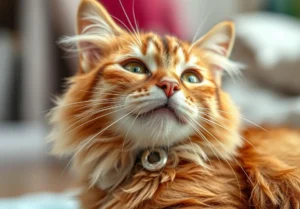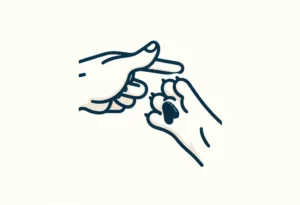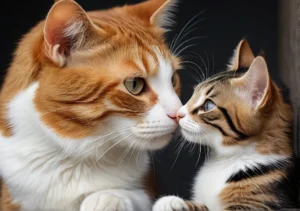
Have you ever noticed how your furry companion meticulously cleans herself after your touch, leaving you puzzled and slightly rejected? It might seem like your caress wasn’t quite up to par for your cat’s liking. However, this behavior isn’t a verdict on your petting skills but a fascinating aspect of feline etiquette. Understanding why your cat insists on grooming herself after being petted can deepen the bond between you two, shedding light on her mysterious ways.
This blog will guide you through the intriguing world of your cat’s grooming rituals post-petting. By exploring the reasons behind this behavior, we aim to enrich your knowledge and appreciation of your cat’s complex nature.
Quick Takeaways:
- Cats groom after petting to remove your scent and reassert their own, ensuring their comfort and security.
- Observing your cat’s grooming patterns post-petting can reveal their stress levels and preferences for affection.
- Adjusting how you pet based on your cat’s reactions promotes a stronger bond and decreases their need to self-groom.
Is It All About Cleanliness?
Ever noticed how your furry friend immediately starts to groom herself after you give her a good petting session? Many cat owners believe this behavior is all about cleanliness. And they’re not entirely wrong.
Cats are notorious for their cleanliness. In fact, they spend a significant portion of their day grooming themselves to get rid of dirt and to keep their fur clean and smooth. So, when you pet your cat, you might be ruffling their fur or transferring some of the oils and dirt from your hands onto their coat. In response, your cat licks herself to smooth her fur back down and remove any foreign scents or particles. It’s like they’re saying, “Thanks for the pet, now let me get back to my pristine state.”
However, as straightforward as this explanation seems, it’s only a part of the story. There’s more to this behavior than meets the eye, which leads us to delve deeper into the realms of scent marking and instinctual actions.
Marking Territory or Removing Yours?
Cats have a sophisticated way of communicating using scents. They have scent glands located on various parts of their bodies, including their cheeks, paws, and the base of their tail. When they rub against you or your furniture, they’re not just seeking affection or being playful; they’re also marking their territory with their scent. So, when you pet your cat and she starts grooming herself afterward, it raises an interesting question: Is she trying to remove your scent or reinforce her own?
The act of grooming after being petted could indeed serve a dual purpose. Firstly, by licking herself, your cat might be trying to remove your scent from her fur, especially if the contact was extensive. Cats value their personal space and might prefer to keep their scent profile “uncontaminated” by others, even their beloved owners.
On the other hand, this grooming behavior could also be your cat’s way of reinforcing her own scent. Licking herself might help to spread her natural oils throughout her fur, reasserting her scent and, by extension, her identity. This aspect of feline behavior is fascinating and reflects the complexity of how cats interact with the world around them.
A Reflex Action or Something More?
Finally, it’s worth contemplating whether this grooming behavior is merely reflexive or if it signifies something deeper. Observing cats over the years, experts believe that grooming after being touched is partly a reflex action. It’s similar to how we might reflexively scratch an itch or adjust our clothes — it’s automatic and not something we put much thought into.
However, labeling this behavior as merely reflexive doesn’t do justice to the intricate nature of cats. Grooming could also be a sign of comfort and contentment. After enjoying a petting session, a cat might groom herself as a way of prolonging the pleasant feelings associated with the affection she just received. In this sense, grooming can be seen as an extension of the bonding process, providing a sense of security and satisfaction.
Moreover, a unique insight that often gets overlooked is how grooming can serve as a self-soothing mechanism for cats. Just like humans engage in certain behaviors to relieve stress or comfort themselves (think of biting nails or tapping feet), cats use grooming as a way to calm down and reassure themselves. After an intense petting session, your cat might feel slightly overstimulated and turn to grooming as a way to regulate her emotions and relax.
In conclusion, the reasons behind why your cat cleans herself after you pet her are multi-layered, encompassing cleanliness, scent communication, reflex actions, and emotional regulation. Understanding these motivations enhances our appreciation of our feline companions and enriches the bond we share with them. So, the next time your cat starts licking herself after a cuddle, remember, it’s her way of communicating in the complex language of Cat.
Stress Relief or Comfort Seeking?
Have you ever thought about why your furry friend scrambles to groom herself after a good pat or cuddle? Some folks might chalk it up to their feline’s fastidious nature, but there’s more to this behavior than meets the eye. Is it possible our affectionate gestures are sending our cats to their personal grooming sessions for a bit of stress relief or comfort seeking? Let’s dive into what the experts say and unravel this furry mystery.
Cats, with their mysterious ways, often use grooming as a tool for self-soothing. According to a study published in Applied Animal Behaviour Science, grooming can indeed serve as a stress reducer for our feline companions. When you stroke your cat’s back or scratch behind their ears, it can evoke a sense of calm and security in them, akin to the care they received from their mothers as kittens. However, immediately after you stop, they might start grooming as a way to prolong that comforting sensation.
Here’s how to tell if your cat is grooming for comfort:
- Look for slow, methodical movements: If your cat’s grooming seems relaxed and unhurried, she’s likely just enjoying the sensation.
- Pay attention to the timing: Grooming that directly follows petting, but doesn’t seem frantic or obsessive, could be your cat’s way of maintaining that contented, comforted feeling.
Unique Insight: What’s not often discussed is the role of scent in this behavior. Cats have highly developed senses of smell, and they use scent to mark territory and identify ‘safe’ spaces. When you pet your cat, you’re mixing your scent with theirs, which can disrupt their sense of security. The immediate grooming might not just be about stress relief but also a way to re-establish their scent. Providing them with a blanket or piece of clothing that smells like you can offer comfort and might reduce the urgency to groom after petting since your scent is already a familiar and comforting presence in their environment.
Does the Way You Pet Your Cat Matter?
Let’s face it, not all pets are created equal in the eyes (or under the fur) of our cats. The manner in which we pet them can significantly influence their need to groom afterward. Ever wondered if a little tweak in your technique could make a world of difference to your cat’s behavior?
Cats are individuals with their preferences and dislikes, which includes how they enjoy being petted. Some might love a good chin scratch, while others might prefer a gentle stroke along their back. Misreading these cues and petting them in a way that’s not enjoyable can lead to them feeling the need to ‘clean off’ the experience.
To reduce the likelihood of your cat feeling the need to groom after being petted, here are a few tips:
- Watch for body language: Tail flicking, ears flattening, or moving away are signs your cat is not enjoying the interaction. Stop petting if you notice these signs.
- Find their sweet spot: Start with common favorites like the base of the ears, under the chin, or along the cheeks. Avoid the belly or tail, as these areas can be sensitive.
- Be gentle: Use soft, gentle strokes. Some cats might be more sensitive than others and prefer lighter touches.
Pro Tip: One piece of advice that’s often overlooked is the importance of letting your cat come to you for affection. Initiating petting when your cat is in a relaxed and approachable mood can decrease the likelihood of them feeling the need to groom right after your touch.
So, there you have it. The nuances of your cat’s post-petting grooming rituals might be rooted in their natural instincts for stress relief, comfort seeking, or even scent marking. By understanding these behaviors and adjusting how you interact with your cat, you can foster a deeper bond and ensure your feline friend feels both comfortable and secure in your company. Remember, the key is patience and observation, as every cat will have its own array of preferences and needs.
Alex, a passionate animal lover, has experience in training and understanding animal behavior. As a proud pet parent to two dogs and three cats, he founded AnimalReport.net to share insights from animal experts and expand his knowledge of the animal kingdom.




